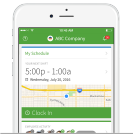Flexible Scheduling In Healthcare: Benefits For Staff, Patients, And Providers
Try When I Work for free
The pandemic placed a huge spotlight on the healthcare worker labor shortage and the difficulty in staffing hospitals and clinics with top-quality candidates.
Yet there are some healthcare organizations that don’t struggle as much—and their secret is flexible scheduling in healthcare. These hospitals stand out for their ability to hire top talent, whether those candidates are new to healthcare or recruited away from somewhere else. How can you compete?
You need to attract, you need to retain, and you need to build the reputation to keep the cycle going.
What is flexible scheduling?
Also known as self scheduling, flexible scheduling is an approach that allows supervisors to determine what the work schedule needs based on demands and requirements, and then lets the workers choose (or trade) shifts for themselves. Using apps or other tools, employees can see what shifts are available. They can select what they want, they can trade with others if a conflict pops up in their plans, and they can communicate about what they are doing.
In other words, there’s no need for the middle man. Managers don’t have to set every individual schedule, they don’t have to handle requests to change shifts— employees do that.
For managers or supervisors, it leads to easier and faster scheduling, even in times when customer demand is uncertain, because every aspect of a shift doesn’t have to be tightly planned. For employees, it gives them more control over how they balance their personal and work life and they no longer blame managers for bad schedules.
There was a noticeable increase in the use of flexible scheduling for hourly workers during the pandemic due to the fluid nature of restrictions and businesses being creative in meeting those challenges while retaining workers. It was a logical solution during a time when customer demand was all over the place.
Why flexible scheduling in healthcare works
While flexible scheduling might be an easy fit for the hourly workplace, it might seem a bit difficult to bring into healthcare with its training and credentialing requirements for workers.
The healthcare industry isn’t exactly known for having a great work-life balance, which is the key ingredient flexible scheduling brings to the table. Yet flexible scheduling isn’t something new in healthcare; it’s been a viable and in-use approach since 1963.
The stressful nature of healthcare jobs is why flexible scheduling was introduced over 60 years ago. The hope was in achieving three outcomes:
- Empower nurses to live more balanced lives. When work-life balance is out of whack, stress and negative attitudes run rampant.
- Increase predictability of scheduling. With flexible scheduling, time is freed up for supervisors responsible for setting schedules. Employees aren’t hit with schedule “surprises” since they are involved with the process.
- Encourage communication about the schedule. Because flexible scheduling is collaborative, there is more communication among stakeholders who are choosing and trading shifts.
While flexible scheduling was first injected into the healthcare industry back in the 1960s, it is as relevant today as then, and maybe even more so.

Why flexible scheduling in healthcare is necessary
As we’ve just shown, flexible scheduling is compatible with the healthcare industry. But even more to the point is that it is necessary in the healthcare industry.
The reality today is that the healthcare workforce is dwindling in numbers. Even before the pandemic, the numbers were clearly headed downward to the point that the federal government was considering options to deal with the situation. Some shortages are in geographic regions (e.g. rural areas) and in fields of study.
This issue was on the radar even 20 years ago, when a study pinpointed what was behind the growing shortage:
- The large Baby Boomer population was aging and would require significant healthcare resources.
- Nurses and other healthcare personnel who are Baby Boomers are aging out of the workforce, and there are fewer graduates to replace them.
- Chronic diseases have increased across the population.
- Recruitment of young nurses is difficult because of poor incentives when compared to other industries.
Depleted workforce. Growing needs. Difficult recruitment hurdles.
This is what the healthcare industry faces, and that’s why the industry needs to find a way to attract workers to the field.
The benefits of flexible scheduling for nurses
As mentioned earlier, flexible scheduling has been growing in other industries. Healthcare workers have friends who are benefiting from this approach, and they see how it makes life less stressful. This means, you’re recruiting not just against other healthcare facilities, but even other industries.
Flexible scheduling is good for recruitment
Success with flexible scheduling means you create a competitive advantage by simply attracting and retaining the best talent when the competition is fierce. Even the slightest advantage in your employee benefits package can be a deal breaker or maker for a new hire.
When potential hires see flexible scheduling as part of the deal, they know that you’re addressing employee burnout, that you care enough to give them some autonomy over their lives, and that if you’re willing to work with them and allow them a say in when they work, you care about what is important to them.
Flexible scheduling is good for patients
It’s not just the healthcare workers who benefit from flexible scheduling. Patients benefit, too, simply because of the problems flexible scheduling solves that has historically led to reduced quality of patient care.
- Employee burnout and turnover. Turnover for registered nurses has increased in recent years. This costs organizations between $4.4 to 7 million a year. Those costs are passed onto patients or lead to cost-cutting measures that affect patient care.
- Reduced absenteeism. When nurses quit, or are frequently absent, a greater workload is put on the other workers, who may become stressed or distracted. It also creates a lack of consistency in individual patient care. When nurses have control over their work lives, they can adjust their schedule to fit what’s going on and are more likely to show up for the shifts they have committed to.
- Increased employee engagement. Engaged employees have good attitudes, and that carries over into how they treat coworkers as well as patients. Giving workers autonomy over their work-life balance is an excellent way of creating engaged employees. It creates a sense of collaboration among groups or teams.
Excellent patient care builds a reputation, and you will find that will also become its own recruitment tool.
Start your free 14-day trial of When I Work! Click here to start scheduling your employees today.

Making flexible scheduling a reality
Flexible scheduling is powerful, but there are still a limited number of healthcare organizations who are able to implement the self scheduling approach on a large scale. The reason? Technological limitations.
To make self scheduling work, you need the right tools and support, like healthcare scheduling software. The healthcare industry is loaded with regulations, compliance considerations, overtime concerns, and other standards. Those add complexity to the start-up process.
Download our free ebook to learn how flexible scheduling benefits you, your staff, patients, and more.






